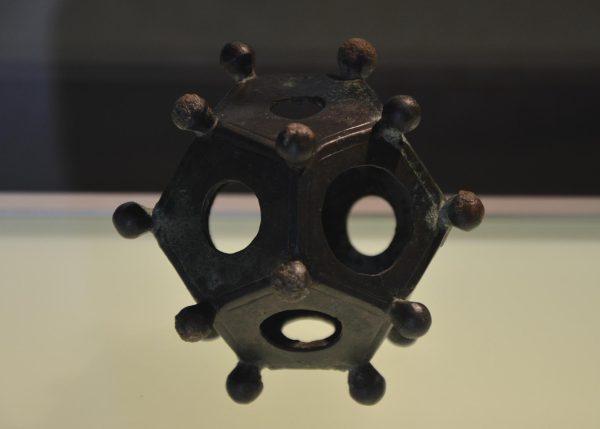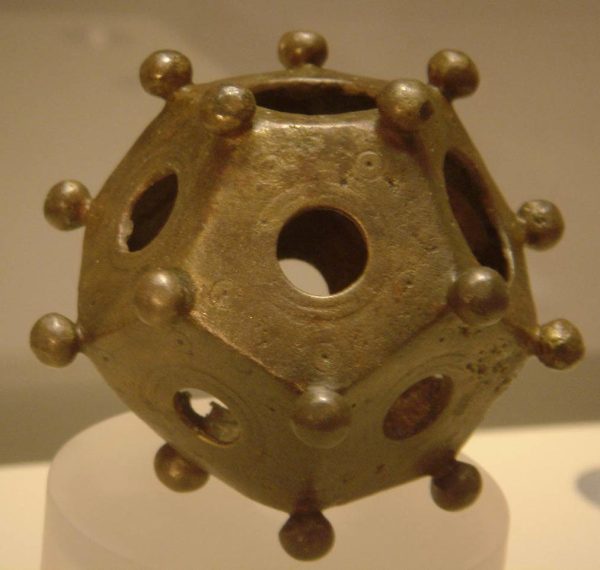Roman Dodecahedrons: Shapes of Incredible Mystery
The shapes we are taught in elementary school are usually rudimentary. Circles, squares, triangles—sometimes, the most ambitious teachers would venture into the world of hexagons, octagons, and beyond. However, we don’t commonly learn more complex shapes until much later, which is a shame, because some shapes seem to be more useful than ever expected. This is exactly how the Roman civilization felt about the mysterious dodecahedrons that seem to make appearances all over excavated areas. What did the Romans even use these weird shapes for?
 Over many years of artifact research, hundreds of these Roman devices have been discovered. Although they have been found all throughout the past territory of the Roman Empire, they have mainly been concentrated in regions of England, France, and Germany. Their usual structure features an evident 12 sides, and each of these individual sides is in the shape of a pentagon. Additionally, they had a hole in the center of the pentagon and some sort of protrusion on each corner and intersection.
Over many years of artifact research, hundreds of these Roman devices have been discovered. Although they have been found all throughout the past territory of the Roman Empire, they have mainly been concentrated in regions of England, France, and Germany. Their usual structure features an evident 12 sides, and each of these individual sides is in the shape of a pentagon. Additionally, they had a hole in the center of the pentagon and some sort of protrusion on each corner and intersection.
Most of the discovered dodecahedrons are constructed from bronze, but more rarely, they are made of bronze and lack the holes and protrusions that others have. They are about the size of a hand and can easily be held, tossed around, and manipulated. The first dodecahedron was found in 1739 in Hertfordshire, just north of London. Some have been uncovered in Hungary and other nations, but most have been found on the banks of the Rhine, and they were surrounded by coins and other riches, indicating that they had some tier of value to their owners.
Theories suggest that the dodecahedrons are not simply remnants of Roman culture, but rather a fusion. When the Romans spread their territory into Northern Europe, they encountered and conquered the people of Gaul. These people resided in a region consisting of modern-day parts of Luxembourg, Belgium, France, Germany, Northern Italy, and the Netherlands. After these territories were added to the Roman Empire, the Celt residents still resided there. This supports the idea that these dodecahedrons were unique to the fusion of Gaul and Roman culture, supported by their official name: Gallo-Roman dodecahedrons.
territory into Northern Europe, they encountered and conquered the people of Gaul. These people resided in a region consisting of modern-day parts of Luxembourg, Belgium, France, Germany, Northern Italy, and the Netherlands. After these territories were added to the Roman Empire, the Celt residents still resided there. This supports the idea that these dodecahedrons were unique to the fusion of Gaul and Roman culture, supported by their official name: Gallo-Roman dodecahedrons.
The challenge in discerning the use of these dodecahedrons is that Roman literature and records do not mention any potential uses or applications. Any proposed solution has little to no evidence at all to support it, so the best bet is to make as many guesses as possible. It is obvious that there was heavy craftsmanship involved in the creation of each individual gadget, so they were objects of importance.
Dodecahedrons have been discovered as recently as January 2024, when the first dodecahedron was found in central England. It was in near-perfect condition and likely made around the 2nd or 3rd century. In fact, this object was in one piece, which was a deviation from the fractured dodecahedrons previously recovered. It was reportedly fragile and was finished by covering it in some sort of liquid metal.
 According to some experts involved with the excavation of this dodecahedron, its lack of a standardized size means it was not a measuring tool, and it was not a tool since it was in pristine condition. The most popular theory among historians and experts is that the object was used for religious and ritual purposes. Romans held superstitions in high regard at the time, and the dodecahedrons could be potentially associated with that.
According to some experts involved with the excavation of this dodecahedron, its lack of a standardized size means it was not a measuring tool, and it was not a tool since it was in pristine condition. The most popular theory among historians and experts is that the object was used for religious and ritual purposes. Romans held superstitions in high regard at the time, and the dodecahedrons could be potentially associated with that.
Other theories for the uses of the dodecahedron include astrology, pole connector, water pipe gauge, knitting tool, candle holder, fish net weight, scepter head, toy, and magical object among others. The potential for these shapes is unheard of. Unless more Roman records are uncovered in the near future, their use will likely never be accurately discerned. The fate of the dodecahedrons might parallel some of our modern-day favorites if their documentation does not survive the same way. In 1000 years, historians might be pondering the use of a doorknob or a yoga ball. Ultimately, the Romans were quite familiar with these objects, and maybe only they will truly know their use.






















































